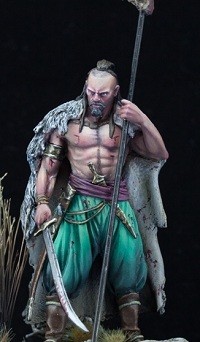Bonjour à tous !
Il arrive de temps en temps que de petits éléments fragile d’une figurine se cassent lors du conditionnement ou du transport. Il n'y a pas si longtemps, j'ai reçu un buste pirate qui avait malheureusement perdu un doigt… Pas de panique ! Je vais vous expliquer comment réparer ça.
Hi everyone!
Sometimes small and fragile elements of a figurine can be broken during the packaging or transport. Not so long ago, I received a pirate bust that unfortunately lost a finger... Don't panic! I'll explain how to fix it.
Etape 1 :
Les bustes à l’échelle 1/12 ou 1/10 sont généralement assez gros pour pouvoir ajouter une structure métallique. Je commence par poinçonner le centre du doigt avec une aiguille pour marquer le trou afin de guider la perceuse à main. Ensuite avec un foret de 0.8, je creuse très lentement un trou de 1 ou 2 mm de profondeur. Si la figurine ne s'y prête pas, vous pouvez choisir un foret plus fin (0.6 voir 0.4).
Step 1 :
1/12 or 1/10 scale busts are usually large enough to add a metal structure. I start by punching the center of the finger with a needle to mark the hole to guide the hand drill. Then with a 0.8 drill, very slowly, I dig a hole 1 or 2 mm deep. If the finger is too thin, you can choose a thinner drill (0.6 or 0.4).
Etape 2 :
Je coupe un bout de fil de fer ou de trombone auquel je donne la forme du doigt. Je le colle ensuite avec de la super glue et laisse sécher quelques secondes. La structure est prête.
Step 2 :
I cut a piece of wire or paper clip and bent it to the shape of my finger. I then glue it with super glue and let it dry a few seconds. The structure is ready.
Etape 3 :
On passe aux choses sérieuses, la sculpture du doigt. Pour les parties anatomiques, j’utilise principalement du Green Stuff pour ses propriétés élastiques qui me conviennent bien pour la peau. Je commence par mélanger les deux composants pendant 2 bonnes minutes afin d’obtenir un mélange bien uniforme, bien vert.
Puis, je viens placer tranquillement les volumes avec de très petits bouts de matière et une lame de scalpel. Ensuite, je commence à lisser la matière avec un pinceau gomme humide afin de donner la forme voulue. C'est l'étape la plus délicate qui demande le plus de patience. N'hésitez pas à utiliser votre main comme modèle. Pour la jonction avec la résine, je pousse le Green Stuff vers la résine en appuyant un peu plus fermement. Je termine par texturer le doigt avec une aiguille pour créer les rides de la peau et l'ongle. La pâte a eu le temps de durcir ce qui simplifie le travail.
Voilà c'est terminé ! Voici le résultat !
Step 3 :
Serious thing are coming, the finger sculpture. For the anatomical parts, I mainly use Green Stuff for its elastic properties that suit me well for the skin. I start by mixing the two components for 2 minutes to obtain a very uniform, very green mix.
Then, I start to place slowly the volumes with very small pieces of material and a scalpel blade. I start to smooth the material with a wet rubber brush to give it the desired shape. It is the most delicate step that requires the most patience. Feel free to use your hand as a model. For the junction with the resin, I push the Green Stuff towards the resin by pressing it a little harder. I finish by texturing the finger with a needle to create wrinkles on the skin and the nail. The material has had the time to dry out, which simplifies the work.
That's it, it's over! Here is the result!


























0 commentaires :
Enregistrer un commentaire